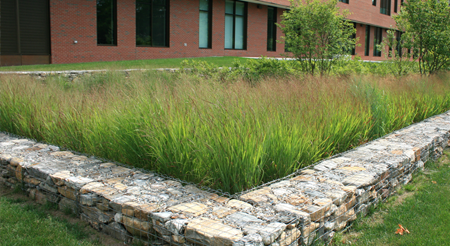
This permit section focuses on mitigating stormwater impacts from new and re-development by requiring practices that treat, store, and infiltrate stormwater onsite. Towns should use the minimum disturbance size they normally regulate (whether it's 0.5 acres per the Erosion Sediment Control Act or smaller if your town uses a lower threshold) for the stormwater retention standards in this section.
Redevelopment: means any construction activity (including, but not limited to, clearing and grubbing, grading, excavation, and dewatering) within existing drainage infrastructure or at an existing site to modify or expand or add onto existing buildings or structures, grounds, or infrastructure.
Low impact development (LID): means a site design strategy that maintains, mimics, or replicates pre-development hydrology through the use of numerous site design principles and small-scale treatment practices distributed throughout a site to manage runoff volume and water quality at the source.
Runoff reduction practices: means those post-construction stormwater management practices used to reduce post-development runoff volume delivered to the receiving water, as defined by retaining the volume of runoff from a storm up to the first half inch or one inch of rainfall in accordance with sections 6(a)(5)(B)(i) or (ii) respectively. Runoff reduction is quantified as the total annual post-development runoff volume reduced through canopy interception, soil amendments, evaporation, rainfall harvesting, engineered infiltration, extended filtration or evapotranspiration.
Water Quality Volume (WQV): means the volume of runoff generated by one inch of rainfall on a site as defined by the Connecticut Stormwater Quality Manual.
- Developing a Sustainable Community by CT NEMO. An easy to use guide to help Connecticut communities craft plans and regulations that promote Low Impact Development and protect water quality.
- LID Site Planning and Design Techniques: Municipal Self assessment by RI NEMO. A comprehensive step-by-step guide for reviewing municipal regulations
- Code and Ordinance Worksheet (COW) by the Center for Watershed Protection. A tool to help communities evaluate their local development regulations to identify revisions that allow (or require) site developers to minimize impervious cover, conserve natural areas and use runoff reduction practices to manage stormwater runoff.
- CT NEMO sample LID checklist for site plans.
- Town of Vernon LID checklist for review of development applications to the Planning & Zoning Department.
- Tree well designs from the Town of East Lyme.
- 15'x 5' Bioswale design from the City of New Haven.
- Bioswale cross section from the City of New Haven.
- CT NEMO's Rain Garden App and website.
- Stormwater wet pond and wetland management guidebook provides detailed guidance on how to maintain stormwater ponds.
- In the Weeds: A Guide for Maintaining Vegetation in Stormwater Treatment Systems in Rhode Island developed by the University of Rhode Island. They also created an app version of this guide which you can get here.
- Long-term Maintenance Plan for LID Installations on Town Property from the Town of Mansfield.
- DCIA tracking spreadsheet developed by CT NEMO long ago.
This video explains all things DCIA in the MS4 permit:
Where the deadline for new MS4 permittees differs from the deadline for exisiting permittees, the second deadline in parenthesis applies to new permittees.
| Activity | Deadline | Permit Page |
|---|---|---|
Maintenance plan for stormwater ponds and treatment structures |
Jul 1 2019 (Jul 1 2020) |
30 |
Determine baseline DCIA |
Jul 1 2020 | 30 |
Review regulations for LID barriers |
Jul 1 2021 (Jul 1 2022) |
27 |
Establish legal authority for site stormwater retention standards |
Jul 1 2021 (Jul 1 2022) |
27 |
The NEMO program presented a virtual workshop series on the impervious cover disconnection portions of the MS4 Permit during December 2020. The presentation slides and recordings can be found below.